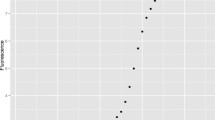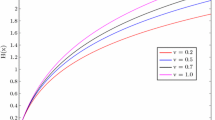Abstract
We develop a multitype branching-process model for the Polymerase Chain Reaction (PCR). We apply the model to a comparison of three methods for estimating the initial number of molecules of target present in a PCR. These three methods are: one which uses a coamplified, internal control; one which uses an external control series; and one which uses simple extrapolation of log outputvs time (no control). We identify assumptions for each method which permit mathematical analysis of bias and precision. All three methods perform well if: (1) replication efficiencies are stable among reactions; (2) other method-specific conditions on efficiencies are met; and (3) product accumulates exponentially throughout the range where it is observed. When replication efficiencies vary among reactions but other optimal conditions for each method hold, the no-control and external-control methods lose precision relative to the internal control method, but they may still perform satisfactorily for many applications. The internal control method continues to perform well even if accumulation of product plateaus. This method depends, however, on a condition we call equivalence of replication efficiencies, the attainability of which in practice remains to be proven.
Similar content being viewed by others
Literature
Abbott, M. A., B. J. Poiesz, B. C. Byrne, S. Kwok, J. J. Sninsky and G. D. Ehrlich. 1988. Enzymatic gene amplification: qualitative and quantitative methods for detecting proviral DNA amplifiedin vitro.J. infect. Dis. 158, 1158–1169.
Becker-Andre, M. and K. Hahlbrock. 1989. Absolute mRNA quantification using the polymerase chain reaction (PCR). A novel approach by a PCR aided transcript titration assay (PATTY).Nucl. Acids Res. 17, 9437–9446.
Chelly, J., J.-C. Kaplan, P. Maire, S. Gautron and A. Khan. 1988. Transcription of the dystrophin gene in human muscle and non-muscle tissues.Nature 333, 858–860.
Chelly, J., D. Montarras, C. Pinset, Y. Berwald-Netter, J.-C. Kaplan and A. Kahn. 1990. Quantitative assessment of minor mRNA’s by cDNA-polymerase chain reaction. Application to dystrophin mRNA in cultured myogenic and brain cells.Eur. J. Biochem. 18, 691–698.
Davis, G. R., K. Blumeyer, L. J. DiMichele, K. M. Whitfield, H. Chappelle, N. Riggs, S. S. Ghosh, P. M. Kao, E. Fahy, D. Y. Kwoh, J. C. Guatelli, S. A. Spector, D. D. Richman and T. R. Gingeras. 1990. Detection of human immunodeficiency virus type 1 in AIDS patients using amplification-mediated hybridization analyses: Reproducibility and quantitative limitations.J. infect. Dis. 162, 13–20.
Gilliland, G., S. Perrin, K. Blanchard and H. F. Bunn. 1990. Analysis of cytokine mRNA and DNA: Detection and quantitation by competitive polymerase chain reaction.Proc. natn. Acad. Sci. USA 87, 2725–2729.
Guatelli, J. C., T. R. Gingeras and D. D. Richman. 1989. Nucleic acid amplificationin vitro: Detection of sequences with low copy numbers and application to diagnosis of human immunodeficiency virus type 1 infection.Clin. Microbiol. Rev. 2, 217–226.
Harju, L., P. Janne, A. Kallio, M.-L. Laukkanen, I. Lautenschlager, S. Mattinen, A. Ranki, M. Ranki, V. R. X. Soares, H. Soderlund and A.-C. Syvanen. 1990. Affinity-based collection of amplified viral DNA: application to the detection of human immunodeficiency virus type 1, human cytomegalovirus, and human papillomavirus type 16.Molec. cell. Probes 4, 223–235.
Jeffreys, A. J., V. Wilson, R. Neumann and J. Keyte. 1988. Amplification of human minisatellites by the polymerase chain reaction: Towards DNA fingerprinting of single cells.Nucl. Acids Res. 16, 10953–10971.
Katz, J. P., E. T. Bodin and D. M. Coen. 1990. Quantitative polymerase chain reaction of Herpes Simplex virus DNA in ganglia of mice infected with replication-incompetent mutants.J. Virol. 64, 4288–5295.
Kellogg, D. E. and S. Kwok. 1990. Detection of human immunodeficiency virus. InPCR Protocols: A Guide to Methods and Applications. M. A. Innis, D. H. Gelfand, J. J. Sninsky, and T. J. White (Eds), pp. 337–347. San Diego, CA: Academic Press.
Kellogg, D. E., J. J. Sninsky and S. Kwok. 1990. Quantitation of HIV-1 proviral DNA relative to cellular DNA by the polymerase chain reaction.Analyt. Biochem. 189, 202–208.
Krawczak, M., J. Reiss, J. Schmidtke and U. Rosler. 1989. Polymerase chain reaction: replication errors and reliability of gene diagnosis.Nucl. Acids Res. 17, 2197–2201.
Linz, U. 1990. Thermocycler temperature variation invalidates PCR results.Bio Techniques 9, 286–292.
Linz, U., U. Delling and H. Ruebsamen-Waigmann. 1990. Systematic studies on parameters influencing the performance of the polymerase chain reaction.J. clin. Chem. clin. Biochem. 28, 5–13.
Mode, C. J. 1971.Multiple Branching Process, Theory and Applications. New York: Elsevier.
Mullis, K. B. and F. A. Faloona. 1987. Specific synthesis of DNAin vitro via a polymerase-catalyzed chain reaction.Meth. Enzym. 155, 335–350.
Nedelman, J., P. Heagerty and C. Lawrence. 1992.Quantitative PCR with internal controls. Technical Report Series 1990 No. 2, University at Albany School of Public Health, Department of Biometry and Statistics, CABIOS, in press.
Noonan, K. E., C. Beck, T. A. Holzmayer, J. E. Chin, J. S. Wunder, I. L. Andrulis, A. F. Gazdar, C. L. Willman, B. Griffith, D. D. Von Hoff and I. B. Robinson. 1990. Quantitative analysis ofMDR1 (multidrug resistance) gene expression in human tumors by polymerase chain reaction.Proc. natn. Acad. Sci. USA 87, 7160–7164.
Rappolee, D. A., A. Wang, D. Mark and Z. Werb. 1989. Novel method for studying mRNA phenotypes in single or small numbers of cells.J. cell. Biochem. 39, 1–11.
Saiki, R. K., D. H. Gelfand, S. Stoffel, S. J. Scharf, R. Higuchi, G. T. Horn, K. B. Mullis and H. A. Erlich. 1988. Primer-directed enzymatic amplification of DNA with a thermostable DNA polymerase.Science 239, 487–491.
Seber, G. A. F. 1977.Linear Regression Analysis. New York: Wiley.
Syvanen, A.-C., M. Bengstrom, J. Tenhunen and H. Soderlund. 1988. Quantification of polymerase chain reaction products by affinity-based hybrid collection.Nucl. Acids Res. 16, 11327–11338.
Author information
Authors and Affiliations
Rights and permissions
About this article
Cite this article
Nedelman, J., Heagerty, P. & Lawrence, C. Quantitative PCR: Procedures and precisions. Bltn Mathcal Biology 54, 477–502 (1992). https://doi.org/10.1007/BF02459631
Received:
Revised:
Issue Date:
DOI: https://doi.org/10.1007/BF02459631




